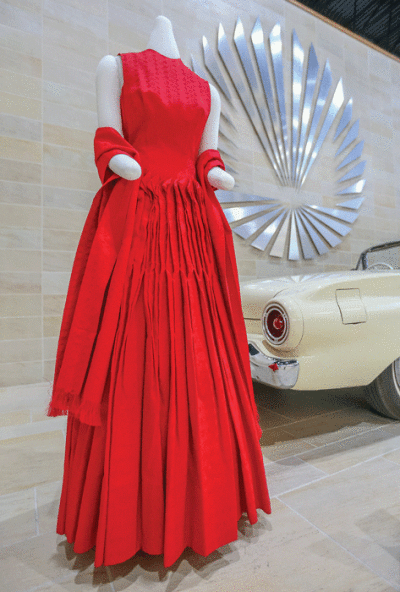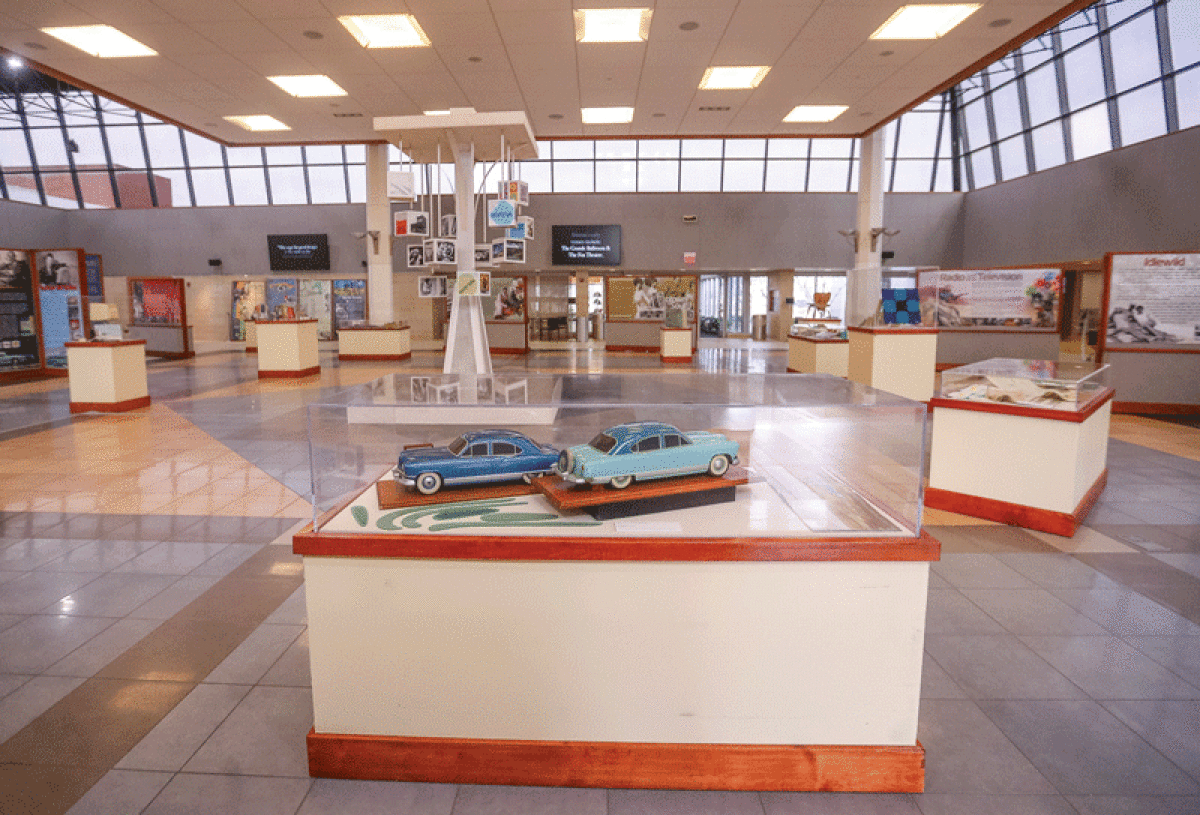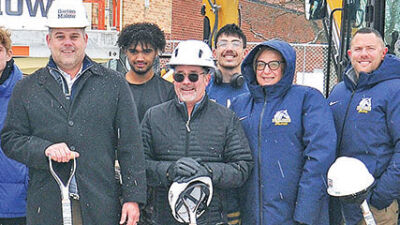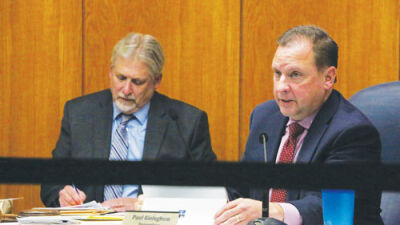
A Ruth Joyce damask evening gown from 1955 is one of the many artifacts on display at the “Creative Michigan: Making The Mitten Modern ‘’ exhibit at the Lorenzo Cultural Center in Clinton Township.
Photo by Patricia O’Blenes
CLINTON TOWNSHIP — Michigan’s rich history is on display right now at the Lorenzo Cultural Center.
From now until April 29, the center will present the exhibit “Creative Michigan: Making The Mitten Modern.” Photographs, artifacts, clothing and more celebrating Michigan’s role in the evolution of modern architecture and design history are on exhibit in the center’s Discovery Hall.
The display items are from the Detroit Historical Museum, the Alden B. Dow Archives, The Henry Ford and private collectors, including Jim Haefner, Debbie Remer, Ed Rice and Lois Jackman.
The exhibit also features the traveling photo exhibit, “Michigan Modern,” with 50 photographs taken by Haefner. The accomplished automotive advertising photographer will be joined at 1 p.m. April 29 by Michigan State Historic Preservation Officer Brian Conway to discuss the Michigan Modern initiative. In the meantime, the public is cordially invited to stop to view the exhibit during its run.
“The Lorenzo Cultural Center’s Creative Michigan program showcases the state as innovator and incubator of modern design and music in the post WWII era,” William Wood, the director of cultural affairs and community engagement at Macomb Community College, said in a prepared statement. “We are offering a great slate of presentations, performances, artifacts and exhibits that will immerse visitors into this intense period of creative advances.”
The exhibit’s first presentation, “Paradise Valley and Black Bottom,” was held March 1 with Detroit historian Jamon Jordan, of Black Scroll Network History & Tours. The guest speaker shared his knowledge of two predominantly Black Detroit neighborhoods: Black Bottom and Paradise Valley. The former Hastings Street connected the two neighborhoods.
Black Bottom was a residential neighborhood bounded by Gratiot Avenue, Brush Street, the Detroit River and the Grand Trunk railroad tracks. Some notable residents of Black Bottom include Detroit’s first Black mayor, Coleman Young, and boxing great Joe Louis.
Paradise Valley was the business district and entertainment center from the 1920s through the 1950s. The boundaries were Hastings Street to the east, John R Road to the west, East Vernor Highway to the east and Gratiot Avenue. In the early 1960s, both neighborhoods were demolished to make way for the construction of Interstate-375.
During the presentation, Jordan shared a virtual tour of both areas, starting with Black Bottom, which was not named after the Black community. The moniker came from early French colonial settlers who named the area after the dark, fertile topsoil found in the area.
“The French called the soil ‘fond noir.’ That’s how it gets its name,” Jordan said. “You know Black Bottom as a Black, historic neighborhood. Prior to the 1930s, this was an integrated neighborhood of immigrants along with African Americans. First, the French and British were there and brought slavery to the city of Detroit.”
The immigrants hailed from Germany, Poland, Italy, Ireland, Greece, Syria and Lebanon. Jordan said that by the 1930s many of the immigrants had moved out of Black Bottom, and the neighborhood became “predominantly African-American.” Housing laws and discrimination prohibited Black residents from living in most other parts of the city.
In the program, Jordan discussed how many of Detroit’s streets got their names. John R, for instance, was named after John R. Williams, who was the first elected mayor of the city of Detroit. Jordan’s video also included input from Bert Dearing, the owner of Bert’s Marketplace in Eastern Market; writer Marsha Music; and architect Emily Kutil, who is creating a project known as the “Black Bottom Street View.”
With photographs of the Burton Historic Collection from the Detroit Public Library, the Street View project will map out images of every house in the Black Bottom neighborhood. According to Kutil, there are about 2,000 photos in the collection. The site will include a searchable database where families can look up homes by family name and address.
“I think it’s really important to preserve the histories of that neighborhood so that future generations can understand its significance and can understand how we came into the place we are today as a city,” Kutil said in the video.
For more information on the Black Bottom Street View visit blackbottomstreet view.com.
Ford Field is one of Detroit’s current structures that now sits on the former Paradise Valley property.
“In the 1920s, ‘30s, ‘40s and ‘50s this would have been the center of the African American business known as Paradise Valley. This business and entertainment district kind of grew as African Americans were migrating from the South to the North,” Jordan said. “We called that period ‘The Great Migration.’ Thousands of African Americans are leaving the South, are leaving conditions of Jim Crow, sharecropping and tenant farming and looking for jobs in places like Ford Motor Co. and other auto factories.
“From the 1920s to the 1950s there are 350 Black-owned businesses that are either in this area or very close. Hotels, restaurants, jazz clubs, stores,” Jordan said. “It will end up being destroyed after the 1956 Interstate Highway Act.”
“Creative Michigan: Making the Mitten Modern” is sponsored by First State Bank, with additional support from the Fred A. and Barbara M. Erb Family Foundation, the Oliver Dewey Marcks Foundation, the Kresge Foundation and the Sonya K. Brett Memorial Endowed Fund for Cultural Enrichment Programs.
The Lorenzo Cultural Center is open 10 a.m.-4 p.m. Tuesdays-Saturdays. For a full list of presentations, visit lorenzocultur alcenter.com. While presentations are free to attend, registration is required. Visits to Discovery Hall to view the exhibits do not require advance registration.
The Lorenzo Cultural Center is located on Macomb Community College’s Center Campus, 44575 Garfield Road in Clinton Township. The phone number is (586) 445-7348. For more information on Black Scroll Network History & Tours, visit blackscroll network.weebly.com.
 Publication select ▼
Publication select ▼





















